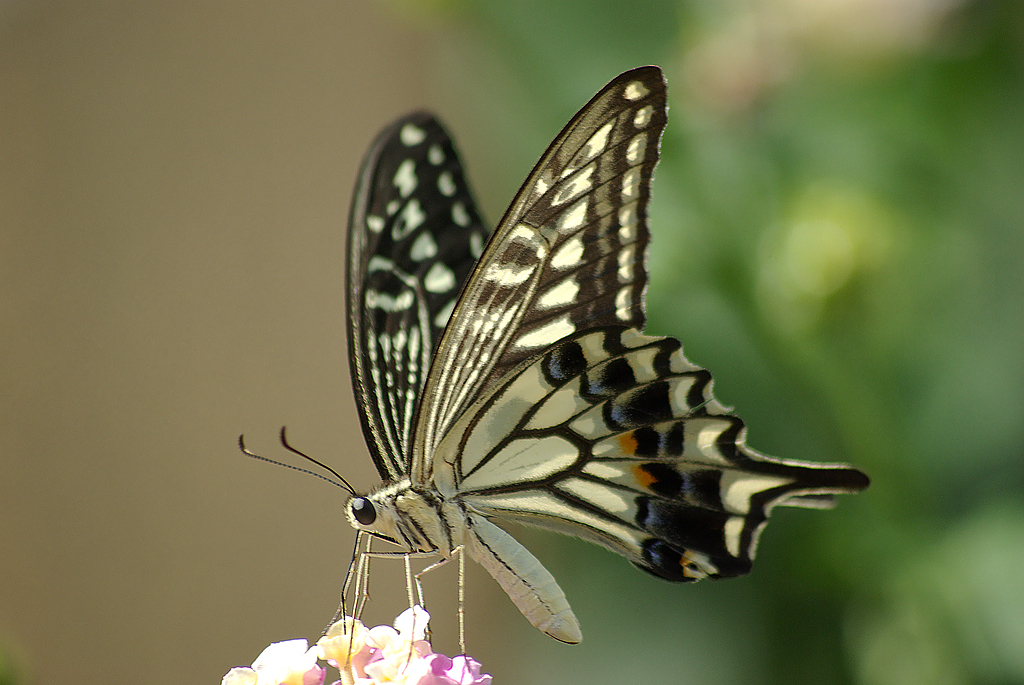Chemical Defense System
 The Papilio
xuthus has an interesting chemical defense system which is why
we chose this particular organism. This defense system comes
from papiliocin. Papiliocin is an anti-microbial peptide that
also has anti-inflammatory properties (Kim et al. 2011).
Anti-microbial peptides are part of the innate immune system.
These peptides kill pathogens that invade the organism.
Researchers have looked at how this peptide affects different
cells. When looking at how papiliocin affected mammalian cells
researchers discovered that it had low toxicity to these cells
but when looking at how papiliocin affected bacterial cells it
had a high toxicity (Kim et al. 2011). This can be due to the
fact that some bacterial cells can be very harmful to the
butterfly resulting in the specific defense system. When
researchers looked specifically at how papiliocin interacted
with bacteria they discovered that this peptide worked better
against gram-negative bacteria like Escherichia coli and
Pseudomonas aeruginosa then it did on gram-positive bacteria.
Researchers also looked at how this peptide kills bacteria
cells. They determined that the papiliocin permeated negatively
charged phospholipid membranes which are found in bacteria
cells. This results in the papiliocin being selective towards
bacteria cells. The papiliocin will then attacks the cell
membrane and eventually kills the bacteria (Kim et al. 2011).
This research can be valuable in discovering new peptide
antibiotics because this peptide is very efficient in killing
bacteria and it has no effect on mammalian cells.
The Papilio
xuthus has an interesting chemical defense system which is why
we chose this particular organism. This defense system comes
from papiliocin. Papiliocin is an anti-microbial peptide that
also has anti-inflammatory properties (Kim et al. 2011).
Anti-microbial peptides are part of the innate immune system.
These peptides kill pathogens that invade the organism.
Researchers have looked at how this peptide affects different
cells. When looking at how papiliocin affected mammalian cells
researchers discovered that it had low toxicity to these cells
but when looking at how papiliocin affected bacterial cells it
had a high toxicity (Kim et al. 2011). This can be due to the
fact that some bacterial cells can be very harmful to the
butterfly resulting in the specific defense system. When
researchers looked specifically at how papiliocin interacted
with bacteria they discovered that this peptide worked better
against gram-negative bacteria like Escherichia coli and
Pseudomonas aeruginosa then it did on gram-positive bacteria.
Researchers also looked at how this peptide kills bacteria
cells. They determined that the papiliocin permeated negatively
charged phospholipid membranes which are found in bacteria
cells. This results in the papiliocin being selective towards
bacteria cells. The papiliocin will then attacks the cell
membrane and eventually kills the bacteria (Kim et al. 2011).
This research can be valuable in discovering new peptide
antibiotics because this peptide is very efficient in killing
bacteria and it has no effect on mammalian cells.
In another study
done to see how papiliocin affects certain cells, researchers
looked at how this peptide affected fungus cells. They wanted to
see if papiliocin could be used as a peptide to treat fungal
diseases. Researchers discovered that the papiliocin affected
the cell membrane of the fungus just like it did in bacteria
cells (Lee 2010 and Kim 2011). Researchers could not identify
the exact mechanism the papiliocin used to invade the cell
membrane but they did conclude that this is how the peptide
killed the cells (Lee et al. 2010). Researchers also noticed
that the papiliocin did not affect the human cells which could
make it a good peptide for antibiotics against fu ngal
diseases (Lee et al. 2010). Another group of researchers also
looked at how this peptide affected fungal cells but
specifically looked at yeast. The type of yeast they looked at
was Candida albicans (Hwang et al. 2011). Researchers
wanted to see how papiliocin killed yeast cells. They determined
that when these cells are introduced to papiliocin that was
derived from the P. xuthus it caused the cells to
produce two substances. The cells produced reactive oxygen
species and hydroxyl radicles which are used in apoptosis in the
C. albicans (Hwang et al. 2011). They noticed that the
papiliocin affected the cell membrane and damaged the DNA. They
determined that the damage to the DNA was due to the cell
undergoing apoptosis. This showed that when the cells are
introduced to papiliocin they will undergo programmed cell death
(Hwang et al. 2011).
ngal
diseases (Lee et al. 2010). Another group of researchers also
looked at how this peptide affected fungal cells but
specifically looked at yeast. The type of yeast they looked at
was Candida albicans (Hwang et al. 2011). Researchers
wanted to see how papiliocin killed yeast cells. They determined
that when these cells are introduced to papiliocin that was
derived from the P. xuthus it caused the cells to
produce two substances. The cells produced reactive oxygen
species and hydroxyl radicles which are used in apoptosis in the
C. albicans (Hwang et al. 2011). They noticed that the
papiliocin affected the cell membrane and damaged the DNA. They
determined that the damage to the DNA was due to the cell
undergoing apoptosis. This showed that when the cells are
introduced to papiliocin they will undergo programmed cell death
(Hwang et al. 2011).
In conclusion
papiliocin that is derived from the P. xuthus can attack cells
in two ways. It can kill the cell by permeating the cell
membrane and then killing the cell as seen in Kim et al and Lee
et al. Papiliocin can also kill the cell by inducing cell
apoptosis as seen in Hwang et al. With this research scientists
can discover new drugs that are made from papiliocin.
Click on the studies to learn more about
them.
Structure and Function of Papiliocin with Antimicrobial and
Anti-inflammatory Activities Isolated from the Swallowtail
Butterfly, Papilio xuthus.
Induction of yeast apoptosis by an antimicrobial peptide,
Papiliocin.